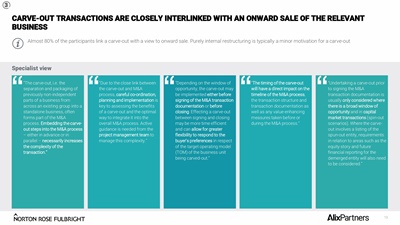
13
Specialist view
CARVE-OUT TRANSACTIONS ARE CLOSELY INTERLINKED WITH AN ONWARD SALE OF THE RELEVANT
BUSINESS
Almost 80% of the participants link a carve-out with a view to onward sale. Purely internal restructuring is typically a minor motivation for a carve-out
"The carve-out, i.e. the
separation and packaging of
previously non-independent
parts of a business from
across an existing group into a
standalone business, often
forms part of the M&A
process. Embedding the carveout
steps into the M&A process
- either in advance or in
parallel - necessarily increases
the complexity of the
transaction."
"Depending on the window of
opportunity, the carve-out may
be implemented either before
signing of the M&A transaction
documentation or before
closing. Effecting a carve-out
between signing and closing
may be more time efficient
and can allow for greater
flexibility to respond to the
buyer's preferences in respect
of the target operating model
(TOM) of the business unit
being carved-out."
"Undertaking a carve-out prior
to signing the M&A
transaction documentation is
usually only considered where
there is a broad window of
opportunity and in capital
market transactions (spin-out
scenarios). Where the carveout
involves a listing of the
spun-out entity, requirements
in relation to areas such as the
equity story and future
financial reporting for the
demerged entity will also need
to be considered."
"The timing of the carve-out
will have a direct impact on the
timeline of the M&A process,
the transaction structure and
transaction documentation as
well as any value-enhancing
measures taken before or
during the M&A process."
"Due to the close link between
the carve-out and M&A
process, careful co-ordination,
planning and implementation is
key to assessing the benefits
of a carve-out and the optimal
way to integrate it into the
overall M&A process. Active
guidance is needed from the
project management team to
manage this complexity."
3